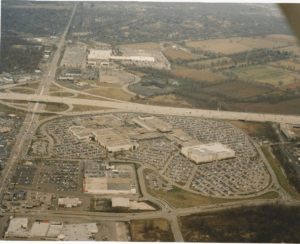How St. Matthews Grew From Farmland to Mall Culture
Writer / Sam Dunn
 The St. Matthews area, once a veritable oasis of wildlife and farmland, is today best known for its shopping and dining experiences. Visitors have a wide variety of options to choose from, but the center piece of the area has long been the mall. One of the largest malls in the state, Mall St. Matthews offers everything from makeup to movie theater tickets.
The St. Matthews area, once a veritable oasis of wildlife and farmland, is today best known for its shopping and dining experiences. Visitors have a wide variety of options to choose from, but the center piece of the area has long been the mall. One of the largest malls in the state, Mall St. Matthews offers everything from makeup to movie theater tickets.
Despite the modern conveniences of the mall, many visitors would be surprised to learn that they are walking around one of the oldest settlements in Kentucky.
During the seventeenth century, before European American colonization, the area was home to several Native American tribes. Part of the fertile Ohio Valley, the area was often used as a hunting ground for tribes such as the Shawnee and Iroquois. Deer, rabbits, and squirrels filled the woods and meadows. Located close to the Ohio River, the easily accessible area was perfect for hunting and fishing.
European Americans, who entered the region around 1779, quickly noticed the favorable location as well. Colonel James John Floyd, a member of the Kentucky militia and compatriot of George Rogers Clark, was the first to settle in the area. His story, one of dangerous migration to the frontier, echoes the lives of many who would come to settle in the region.
Born in 1750, in Virginia, Floyd came from a relatively prosperous family but hoped to establish himself on his own. After training as a surveyor, he was selected to lead a team of surveyors into the wild frontier west of Virginia in 1774. Floyd was only 24 years old. Very quickly, the group faced hardship and danger. Disease and crippling accidents were an ever present danger. Threats from Native Americans, who were engaged in a long series of wars with settlers, further scared off some of his group. Despite the risk, Floyd persisted. Upon reaching the St. Matthews area, he recognized the quality of the land and bought a 2,000-acre plot for himself.
Floyd’s adventures in Kentucky would continue, involving narrow brushes with death and run-ins with some legendary figures. Most notably, he helped to rescue Daniel Boone’s daughter Jemima after she was kidnapped by a group of Native Americans. During the Revolutionary War, Floyd served on a privateer ship, working to capture British vessels. His war story, reflecting his earlier adventures in Kentucky, is full of near misses and daring escapes.
 Throughout all of his adventures, Floyd never forgot about that land he had bought in Kentucky. Returning in 1779, he is widely believed to be the first settler in Jefferson County. Other settlers from Virginia came to the area, eventually creating a frontier settlement and laying out plans for the city of Louisville.
Throughout all of his adventures, Floyd never forgot about that land he had bought in Kentucky. Returning in 1779, he is widely believed to be the first settler in Jefferson County. Other settlers from Virginia came to the area, eventually creating a frontier settlement and laying out plans for the city of Louisville.
Over the next several decades, the settlement continued to grow. Profitable plantations grew tobacco and hemp. Enslaved peoples, many of whom were brought to the area by their Virginia owners, did most of the labor. Agricultural products, as well as horses and other livestock, remained the primary export of the region for many years. The name of the settlement changed several times. By the 1840s, it was known as Gilman’s Point or Gilman’s Station, after a local tavern owner who operated his business at the juncture of several prominent roads that still exist today.
Modern day residents will be familiar with several of these road names, including Shelbyville, Westport, and Frankfort Avenue.
Notwithstanding the apparent popularity of the tavern, several citizens argued that the fast growing city deserved a more appropriate name. Thus, the name St. Matthews was adopted around 1850, named after the recently built St. Matthews Episcopal Church. Additional churches, such as Holy Trinity of Trinity High School, were founded over the next 40 years.
Even as St. Matthews grew, its focus on agricultural products continued. The great plantations, changed forever by the Civil War, were often divided up and sold. Famers shifted their focus, finding that the land was suited for growing root vegetables, particularly potatoes. The St. Matthews Produce Exchange, founded in 1910, became the second largest potato shipper in the world. Around this time, St. Matthews became known as the “potato capital of the world.” The potato boom, and the subsequent fame, ended around 1946. By this time, as the Exchange closed its doors, St. Matthews was rapidly developing.
The St. Matthews area had begun to more heavily develop in the early twentieth century, when larger properties were first split into residential lots. The financial boom of the 1920s corresponded to further growth in the area, although it was limited by the subsequent Great Depression. A second phase of growth occurred after the Great Flood of 1937, when more than 70% of Louisville was submerged. An estimated 175,00 residents were forced to flee. Many of them never returned, choosing to settle in nearby settlement such as St. Matthews.
The area would continue to grow until the attack on Pearl Harbor and World War II. Urban development was not considered essential to the war effort and many of the perspective home buyers were involved in more weightier pursuits.
St. Matthews saw its last phase of growth after the war, fueled by returning soldiers who began to build family homes. Modern businesses grew, providing jobs and shopping opportunities. The agricultural characteristics of St. Matthews, present since the days of Floyd and the frontier, now gave way to the contemporary urban growth that visitors see today.
The city of Louisville, laid out by the original settlers of St. Matthews, began a series of attempts to annex the area in the 1940s. After citizens of St. Matthews protested, the state Court of Appeals ruled against the annexation in 1950. That same year, St. Matthews was incorporated as a sixth-class city. Today, while a part of the Louisville Metro government, it is still classified as a home rule-class city.
The Mall St. Matthews, familiar to locals and tourists alike, continued the St. Matthews tradition of making history. Work started on the structure in 1961. Originally to be named Shelbyville Center, by the time work was completed in 1962 organizers had settled on a snappier name. It was to be called, simply, The Mall.
The opening of The Mall, the first indoor suburban shopping mall in the state of Kentucky, generated a significant amount of attention. The Lieutenant Governor of Kentucky attended, and the crowd was entertained by the local Waggener High School Band. Many of the original businesses housed in The Mall might seem unfamiliar to today’s shoppers. At the time of its opening, the mall included a Kaufman’s Department Store, a 25-cent store, and an A&P Supermarket.
Smaller businesses included Benton’s Tweed Shop, Bell Shoes, Sutcliffe’s Sporting Goods, and Maud Muller Candies. Although the names have changed, St. Mathews shoppers still shop for the same things today: clothes, shoes, sports gear and candy.
The Mall continued to grow over the next decades. Mall owners proudly unveiled a J.C. Penny in 1970. At this point, the mall covered an area of about 552,000 square feet. Older, or less fashionable stores, moved away from the mall and were replaced by newer ones. The cycle continued uninterrupted, even as the Oxmoor Center was built in the 1970s and The Mall was renamed Mall St. Mathews in the 1980s.
However exciting the name change, it did little to limit competition from the new Oxmoor Center. By 1990, business had slowed. Responding to growing concerns, the space was renovated. It was at this point that the popular Bacon’s department store chain was acquired by Dillard’s and renamed. The store has remained open ever since.
As the mall continued to change, modern brands began to emerge. Forever 21 opened in 2011. Cinemark opened in 2013, on the site of the old Kaufman’s Department Store. Dave & Buster’s opened in 2019.
Mall St. Mathews had grown, now spanning over one million square feet. Although the mall has undergone many changes, customers have been shopping and socializing there for more than 60 years.
It is hard to say what past residents of St. Matthews would say about the area today. After all, it has changed significantly over the years. From hunting ground to settlement, from settlement to farmland, and from farmland to an urban landscape. Most likely, they would be amazed.





